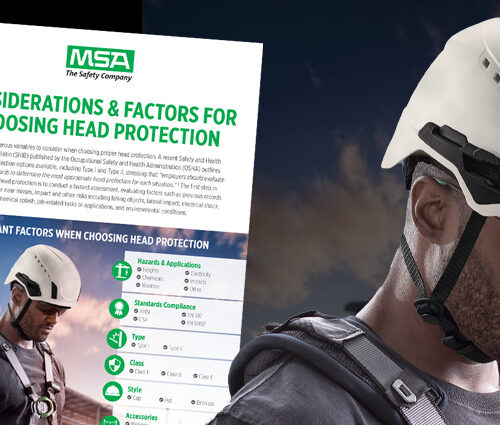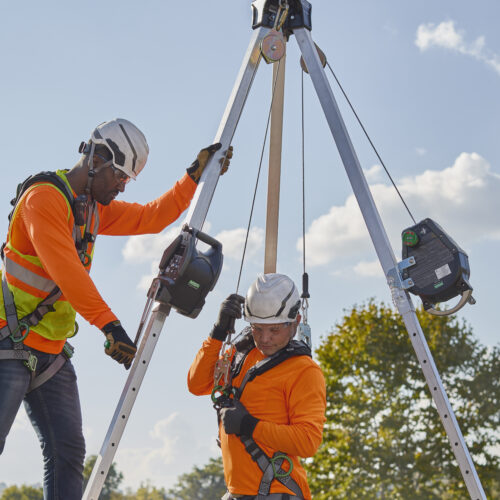
Heat stress is often a significant concern for workers in outdoor industrial environments, such as construction, working at height, and oil and gas, especially during the summer months. With temperatures rising, the Occupational Safety and Health Administration (OSHA) implemented a National Emphasis Program (NEP) on Outdoor and Indoor Related Hazards, which has been effective since April 8, 2022 and will remain in place for no more than three years from that effective date.¹ In July 2024, OSHA announced a proposed rule aimed at helping protect workers from the risks of heat stress, which would establish enforceable guidelines and requirements for employers.4 The purpose of the NEP is to “ target high-risk industries and focus agency resources and staff time on heat inspections.”¹ Here is an overview of the OSHA NEP on heat stress and some tips to help reduce heat stress for industrial workers in outdoor environments.
OSHA NEP on Heat Stress
The OSHA NEP on heat stress is aimed at reducing the risk of heat-related illnesses and injuries in outdoor workers. The program emphasizes the importance of helping to prevent heat stress and provides guidance on how to implement effective heat illness prevention programs.
Under the NEP, OSHA compliance officers are expected to evaluate the heat-related hazards in the workplace, including the environmental conditions, job tasks, and personal protective equipment (PPE) used by workers. The NEP prioritizes heat-related interventions and inspections of work activities on days when the heat index exceeds 80°F.² Employers are also encouraged to implement a heat illness prevention program that includes the following elements:
- Written Plan: Develop and implement a written plan that outlines the procedures for preventing heat-related illnesses and injuries. The plan should include provisions for monitoring weather conditions, identifying high-risk tasks and employees, and providing appropriate training and PPE.
- Training: Provide training to employees and supervisors on the signs and symptoms of heat stress, how to prevent it, and what to do if a worker shows symptoms. Training should also include information on the importance of hydration and the use of PPE.
- Water, Rest, and Shade: Provide access to water, rest, and shade for workers who are at risk of heat stress. Workers should be encouraged to take breaks in shaded areas, and employers should provide cool water for drinking and cooling.
- Acclimatization: Implement a program to gradually acclimate new and returning workers to hot weather conditions. This can include starting with shorter work shifts or reducing the physical demands of the job until workers are fully acclimatized.
- Monitoring: Monitor workers for signs and symptoms of heat stress and provide medical treatment as necessary. Workers should also be encouraged to report any symptoms to their supervisor or a designated safety coordinator.
- Buddy System: For new workers especially, employers are encouraged to implement a buddy system so that these workers are not alone in extreme heat conditions.
What to Expect During OSHA Heat-Related Inspections
OSHA Instructions include the below actions for compliance safety and health officers during heat-related inspection.³
- Review OSHA 300 logs and 301 Incident Reports for any entries indicating heat-related illness(es).
- Review any records of heat-related emergency room visits and/or ambulance transport, even if hospitalizations did not occur. (This may require the use of a Medical Access Order.)
- Interview workers for symptoms of headache, dizziness, fainting, dehydration, or other conditions that may indicate heat-related illnesses, including both new employees and any employees who have recently returned to work.
- Determine if the employer has a heat illness and injury program addressing heat exposure.
- Document conditions relevant to heat-related hazards.
- Identify activities relevant to heat-related hazards.
Tips to Help Reduce Heat Stress
In addition to implementing the OSHA NEP on heat stress, there are several tips that employers and workers can follow to help reduce the risk of heat-related illnesses and injuries in industrial work environments:
- Wear Appropriate Clothing: Workers can wear loose-fitting, lightweight clothing that allows for ventilation and sweat evaporation. Clothing that is light-colored can also reflect sunlight and heat.
- Use Cooling PPE: Employers can provide cooling PPE, such as cooling vests or bandanas, to help regulate body temperature in hot environments. Innovative cooling technologies, such as the ReflectIR™ Thermal Barrier technology featured in the MSA V-Gard C1™ Hard Hat can also help to reduce heat stress by keeping the inside of the hard hat up to 20°F cooler. The C1 also includes a moisture-wicking sweat band with breathable foam padding for additional comfort and sweat management.
- Stay Hydrated: Workers can drink water frequently throughout the day, even if they do not feel thirsty. Employers can also provide electrolyte drinks or popsicles to help replace lost fluids and minerals.
- Take Frequent Breaks: Workers can take frequent breaks in shaded areas or air-conditioned spaces – to help regulate body temperature and avoid heat stress.
- Limit Sun Exposure: Workers can avoid direct sun exposure whenever possible and use sunscreen with a high SPF to protect their skin.
Heat stress is a significant concern for workers in outdoor industrial environments, but the implementation of the OSHA NEP on heat stress and the adoption of effective prevention programs, can help reduce the risk of heat-related illnesses and injuries.








